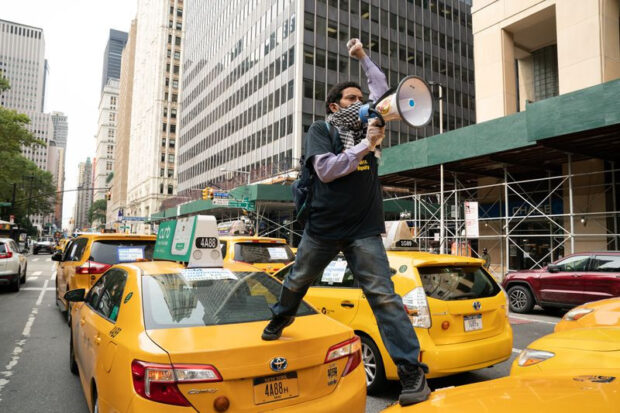
How the right to be a taxi driver in New York was sold for a million dollars, became a tool of financial fraud and a reason for suicide – and what the city authorities are doing now when desperate taxi drivers are standing outside the windows of the City Hall.
The mayor of the most populous metropolitan area in the United States announced that $ 65 million will be paid from the city fund to help victims of coronavirus infection. However, this money will not go to bankrupt coffee shops or families who have experienced loss – it will go to pay off loans from New York taxi drivers. This event brought confusion.
At the center of this story are taxi licenses. 10 years ago, buying could be compared to investing in stocks. In addition to the right to legally transport passengers in the driver’s own car, the license holder received a steadily growing asset as property. Since the pre-war years, buying a license at a young age has made it possible to think less about old age – its price has steadily increased for many decades.
See also 9 Best Hikes Near NYC: Most Interesting Places in the Hudson Valley

So far, financial fraud and failed city politics have not led to the collapse of the entire license market and the bankruptcy of thousands of taxi drivers.
2019 investigation revealing auction fraud, city government silence. The coronavirus pandemic and the ensuing crisis of 2020-2021 brought taxi drivers en masse under the walls of the New York City Hall.
The mayor of the city was forced to admit the existence of the problem and propose a solution – unfortunately unconvincing. Three thousand taxi drivers were promised a payment of $ 29,000 (with an average debt load of $ 500,000). On a reimbursable basis, although without interest. In fact, the mayor invited the drivers to pay part of the amount not to the bank, but to the city. And he expressed the hope that the creditor banks would also get into the situation.

The New York City Taxi Union picketed the City Hall every day from 8:00 to 23:30, demanding full gratuitous reparations from the city.
In their opinion, it is the city authorities that are to blame for the crisis, which did not stop the fraud at the auctions and did not conduct an information campaign. This actually forced taxi drivers who want to work on their own cars to get into millions of dollars in debt. The mayor refuses these requirements. “If the mayor wants war, he can have war” – the union members answer this.
The plan, to be put in place by City Councilor Ritchie Torres, calls for the city council to pass laws to force private lenders to re-evaluate each taxi medallion at $ 250,000. In return, the city would act as a guarantor for any outstanding loans and cover the costs of drivers who default on their payments.
This plan would effectively lower drivers’ monthly payments to an average of $ 1,100 per month and dramatically reduce the risk of default for the city’s taxpayers. An amount just over a thousand dollars is well below the current monthly sums of $ 3,000 and $ 4,000, which are driving thousands of taxi drivers into financial ruin and even suicide.
The yellow cab industry is having another go at carpooling by taxi. Many owners can no longer pay their installments for acquiring the concessions.
“The debt is crushing these guys,” Dange told the New York Post. “The average pre-COVID driver drove about 17 trips a day and barely made ends meet.” Councilor Torres, a longtime fighter alongside medallion owners, said he will add the Medallion Asset Rehabilitation Program (MARP) to the budgeting process next week of the Council. “The city was involved in the collapse of the medallion market. This complicity goes hand in hand with the responsibility to save them. “
Torres means that until 2014 the city had sold taxi medallions for $ 1.3 million each and led buyers to believe that the investment was “better than the stock market”. With the start of Uber and Lyft, the medallion value collapsed massively, today it is only around 130,000 dollars in isolated cases. Last year, reports surfaced that taxi industry officials and city officials had artificially raised medallion prices, including by easing regulatory restrictions.
The new proposal comes after a New York panel launched a plan in January to create a public-private partnership to save cab drivers by buying back the medallions. That January plan would cost over $ 500 million.
Proponents of the current plan, meanwhile, argue that it would bypass the need for an expensive bailout. A valuation of $ 250,000 for each medallion, Dange said, could reduce the risk of a number of loan defaults for most lenders while meeting the New York Taxi Workers Alliance’s call for a cap on all medallion debt.
See also Why We Can’t Climb the Torch of the Statue of Liberty: the Reasons are Kept in History
The deliberations are still at an early stage, which is why it is not yet clear how the lenders will react. Marblegate Asset Management, a hedge fund that recently acquired 3,000 medallions, has not commented yet. However, the fund is believed to have had its medallions worth well under $ 150,000.
Dange and his co-founder Zahid Biviji, whose app is helping drivers identify areas where Uber and Lyft are seeing price spikes so they can get in at a lower price, say their plan is designed to make sure medallions have enough value so that their owners can build equity over time.
Like us on Facebook for more stories like this: